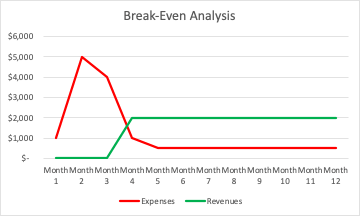If you run a business of any kind, it’s important to understand the relationship between business expenses and revenue. When planning out any kind of business investment, it’s a good idea to map out the costs and expected business results and conduct a break-even analysis.
Keep reading to learn more about what a break-even analysis is, why it can be helpful to your business, and how to do your own break-even analysis for a new business or business expansion project.
What is a break-even analysis?
A break-even analysis is a type of analysis in which business owners or managers run the numbers to decide if a new business or a business project is going to pay for itself or break even.

For example, if you are considering investing $50,000 to open a new franchise or $10,000 for equipment for your existing business, you are going to want to know if that investment will pay off.
Depending on how you put your break-even analysis together, it could also tell you when you can expect an investment to pay back.
Why would your business need a break-even analysis?
We already looked at the examples of starting a new business or investing in business expansion as times a break-even analysis could be helpful.
Here are two of the most common reasons businesses would want to spend the time to do a break-even analysis, even on a project that seems obvious.
Better prepare for the future
Whether it’s a brand new business, a new business line, or a project that will save your business money or help it grow, a break-even analysis can help your business prepare for the future.
It’s hard to run a business when you don’t know what your cash flow is going to look like.
That’s why most large businesses and many successful small businesses invest in creating a cash flow statement. Public companies are required to publish this type of information.
When running your business, it’s a good idea to put together a budget that charts out revenue and expenses. Layering a break-even analysis on top can help your business better prepare for the future.
Create rules for your business to remain solvent
In capital-intensive industries, there are seemingly endless opportunities to invest in new equipment or other resources to help your business grow. The problem is, some businesses invest so much that they run out of money. If a project won’t pay off in time, an investment or new business expansion could lead to bankruptcy.
With a break-even analysis, you can create projections and rules that help your business remain solvent. Drawing a firm line and creating hard rules about liquidity, investments and break-even timelines can help your business remain financially sound.
How to do a break-even analysis?
If you’re sold that a break-even analysis could help your business in the future, follow these four steps to conduct your own break-even analysis.
1. Estimate the cost of your project
Start by estimating the full cost of your new business project.
Be sure to take into account every related cost. That may include equipment costs, outside consulting, employee labor, maintenance, real estate costs, web hosting costs, subscriptions, supplies and any other related expenses.
2. Break out your project costs by month
Now that you know what it’s going to cost in total, break out those costs by month, quarter, year or another time period. Use whatever will be most useful for your business. This cost forecast is useful to help keep your project on budget in the future, even after you’ve done your break-even analysis.
3. Estimate future project revenues (or cost savings)
Most businesses make decisions around reaching higher profitability. That means you could invest in a project to save your business money going forward or to earn more revenue.
Just as you forecasted your costs, you should forecast future revenues or savings you expect from the project.
4. Find the point where the project would break even
Now you have an expense forecast and an income forecast. You can line those up to find the point where your project breaks even. Here’s an example of a simple break-even analysis:

In the example above, you can see that the project requires heavy up-front expense and doesn’t start to generate revenue until the fourth month. The project breaks even in month 10 and earns a profit in future months.
In the chart below, also created in Excel using the table above, we can see that the project turns cash flow positive after just four months. If the company can afford the investment through that point, it becomes cash flow positive in month four. That’s another useful data point when deciding whether to move forward with a new business or project.

Next steps
Now that you know what a break-even analysis is and why conducting one is useful, you can apply the concept to your business. It may not be worth the time to conduct a break-even analysis on a small purchase like a new office printer, but when making large decisions that involve a significant investment, break-even analysis is almost always worth the time and effort.
Large corporations employ teams of financial analysts to conduct this type of analysis on a regular basis. They wouldn’t invest without knowing they are going to make money, and you shouldn’t either.
You don’t have to be a huge company to do a break-even analysis or make one worthwhile. Even small and brand new businesses can put them to use. If you do, you’ll know if that next project isn’t going to pay off. But if it is, you can confidently move forward knowing exactly when you should break even.
The information contained in this blog is provided for general informational purposes only, and should not be construed as an endorsement or advice from GoDaddy on any subject matter.
The post What is a break-even analysis? appeared first on GoDaddy Blog.




